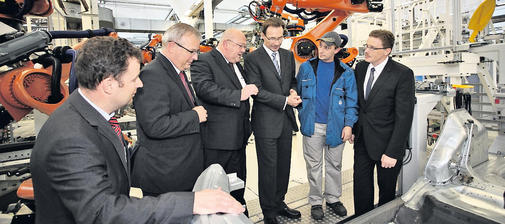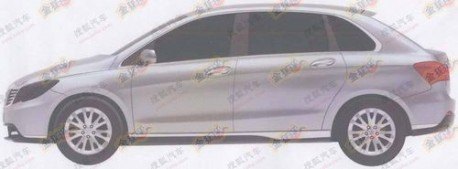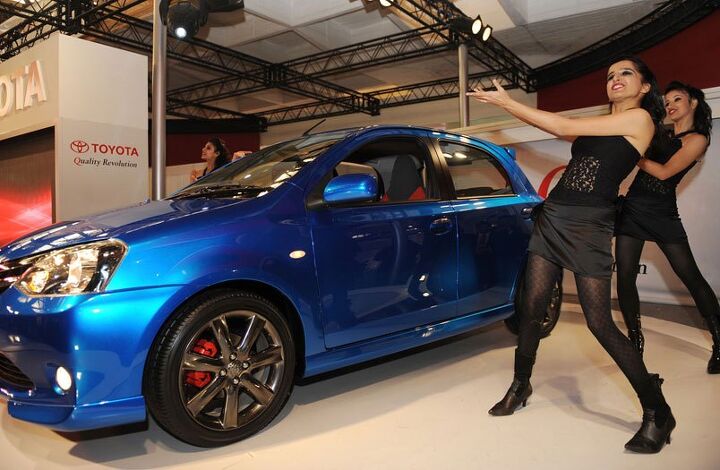Argentina: Want To Sell Porsches? Export Our Wine And Olives
With a 35% import tax on new cars, Argentina is already a touch market for foreign brands seeking to bring cars into the country. But the Argentinean government has just made it little bit harder by demanding that importers export an equal amount of Argentina-made goods for every car imported. As a result, Bloomberg reports that Porsche’s importer is exporting Malbec wines and olives, Mitsubishi’s importer is getting into the peanut export game, and Subaru’s representative is shipping chicken feed to Chile. BMW, which has had recent difficulties importing into Argentina, is focusing on its core business, exporting auto parts and upholstery… and a little processed rice to make up the difference. But why are these major manufacturers getting into all kinds of strange side businesses just because Argentina wants to improve its trade balance and foreign currency reserves? Simple: Argentina is South America’s second-largest economy, and it’s been growing at over 5% per year since 2007 (i.e. when other markets were shrinking). So if the government wants imports balanced with exports, well, Porsche’s importer is just going to have to get into the wine business, isn’t he?
ZAP Still Alive, Alias Still Coming (Or Not)
The Nano No-No: Export Launch Delayed Over… High Price?
Designed to be the world’s cheapest car, the Tata Nano is supposed to compete with scooters and three-wheelers rather than full-priced, global-brand vehicles. But the Nano has already seen several price increases since the target MSRP of $2,500 was announced, and the price in India for a base-level Nano is now about $2,870. And when you talk about such low prices, even small increases can wreak havoc on expected volumes, and as a result the Nano is turning into something of a flop (helped along by its pyromania problem).
The Heat Is On In Indonesia
Carmakers don’t want to be caught napping when the “next China” is at stake. They are setting their sights on Southeast Asia. Currently en vogue: Indonesia. The country with a population of 237 million has a bullet on the PowerPoints of most major carmakers. Toyota is already there and wants to double down.
Get Sterilized, Receive A Tata Nano
With a massively growing population, and no Chinese-style national one-child policy in place, sterilization campaigns in India’s provinces and municipalities are far from uncommon. But now, in the Rajasthani district of Jhunjhunu, officials in charge of sterilization campigns have found a new incentive to encourage Indians to undergo the procedure: the subcontinents growing obsession with automobiles. Britain’s The Independent was the first Western news outlet to report on the scheme, which offers those undergoing sterilization
a coupon for a forthcoming raffle, with prizes including a Tata Nano car, motorbikes and electric food blenders.
Honda Joins The Guanajuato Gold Rush, Toyota On The Way?
Around the time of the founding of the United States, the Mexican state of Guanajuato became home to of the one of the biggest silver mines in the world, which produced as much as 2/3rds of the world’s supply of silver at its peak. Today it’s not precious metal that’s driving Guanajuato’s booming economy, but cars, as the world’s automakers flock to Central Mexico. Between 2005 and 2008, GM, Ford and Michelin dumped $1.8b into production in the state, and the expansion is still picking up steam. In the last year, Volkswagen invested $800m in engine production capacity in Silao, Pirelli built a $210m facility and Mazda just revealed it would build a new compact car plant there in June. Toyota is said to be the next to set up shop in Guanajuato, but for the moment Honda is the latest automaker to announce new operations in Guanajuato, as Automotive News [sub] reports the Japanese automaker will spend $800m on an assembly plant there. Honda, which is fleeing a strong yen which has battered Japanese exports, will start building 200k subcompacts per year in 2014. Clearly Guanajuato’s got it’s automotive mojo flowing… but are the days of new Japanese transplant factories in the US over? Is it only a matter of time before the coyotes start smuggling Detroiters into Silao, Celaya, and the Puerto Interior??
GM Reactivates Indonesia
GM knows where the growth is: In the emerging markets, BRICs and beyond. GM announced today it will “invest $150 million in the reactivation of its Bekasi manufacturing facility in West Java, Indonesia.”
China's July Car Sales Edge Up While Associated Press Slips Badly
From the Detroit News all the way to the Miami Herald, you will receive the good news that “China’s July auto sales are up 6.7 percent.” They are not. According to data released by the China Association of Automobile Manufacturers (CAAM), automobile production in China rose 1.26 percent in July to 1,306,100. Sales rose 2.18 percent to 1,275,300. In case you don’t read Chinese, China Daily provides a translation. The numerical crime was perpetrated again by the Associated Press. The AP is a repeat offender.
The Revolution Of The Car Industry: Kit Cars
Within the next ten years, the car industry will change more than in the past fifty years. At least at Volkswagen, says Audi Chief Rupert Stadler. Platforms are a thing of the last century. The future of the car industry is kit cars. Or make that cars designed and built using elements of a common kit architecture. Currently, there are two families of erector kits which can be assembled into all kinds of cars at Volkswagen. They have Teutonic names like “Modularer Querbaukasten” (MQB) and “Modularer Längsbaukasten” (MLB). Porsche is developing a “MMB” (Modularer Mittelbaukasten) for Mittelmotor (mid-engined) cars. Or possibly a MSB (Modularer Standardbaukasten), which could be the Mutter of all Baukasten.
Audi is already working with the MLB architecture. This coming year, Volkswagen will start using the MQB. Says Automobilwoche [sub]:
Toyota's Etios Coming To China?
Toyota is working on a small car based on its emerging market platform that underpins the Indian Etios, and will release it in China by 2013 – if The Nikkei [sub] is correctly informed. There is nobody working at Toyota on Thursdays and Fridays as a power saving measure, so there is nobody to ask. We expect no more than the usual “we cannot comment on future models” when people will be back to work on Saturday. With that in mind, let’s go down rumor lane.
Chinese EVs: And Now, Daimler And BYD
After a lot of prototypes presented at Chinese car shows with hoods closed and long cables going to mock charging stations, EV development appears to get serious in China. Yesterday, Nissan announced that it is developing an EV for the Chinese market that will be sold under the Venucia brand by 2015. Daimler of all people could be further ahead.
United Nations: This Is Your Car On Ethanol
A chicken could become as unreachable as caviar in many poor countries, warns a study of the OECD and the United Nations. Chicken is projected to rise in price by 30 percent in the next ten years – inflation adjusted. Other staple foods such as corn, sugar or cooking oil are seen rising in price by twenty percent. Why? On one side of the ledger is higher demand, mainly from China and India. On the other side: „Increasingly, the crop doesn’t end up in the pot, but as fuel in the tanks of cars,“ says the German magazine Der Spiegel.
Leaf, Made-in-China: Lost In Translation
China’s Gasgoo says that “Dongfeng Nissan has already begun preparations for domestic production of the Nissan Leaf pure electric hatchback.” Domestic as in Made-in-China. They quote Dongfeng Nissan CEO Fumiaki Matsumoto, who allegedly said: “We have already finished preparatory work for the Leaf. We hope that we can cooperate with the government and suppliers to bring over the Leaf as soon as possible.” That of course piqued our interest. After some calls, we can say with certainty: Instead of millions of Leafs roaming the streets of China tomorrow, we have a case of Lost In Translation with a French-Japanese-Chinese cast.
Trade War Watch 18: DetNews Fumbles With The Saber
Just over one week ago, a Detroit News piece pointed me towards a letter written by Senators Carl Levin and Debbie Stabenow, which took China to task for considering draft legislation that might possibly require more technology transfers to Chinese companies as a precondition to market access. Having chased down both the letter and the US National Trade Estimate it was based on, as well as several reports on the draft legislation itself, I wrote a lengthy piece about how Senators Levin and Stabenow were rattling the saber about what appeared to be a complete non-issue. In that piece, I not only debunked the senators’ concerns, but I also pointed out that China’s local consumer EV subsidies were the far more worrying potential trade barrier, as we have been hearing that they require that all qualifying EVs be built in China and sold with Chinese brands (a condition at odds with at least the 2004 version of China’s Auto Industry Development Plan, which stated “local governments should encourage fair competition among motor vehicles made by different places on the local market. They are not allowed to carry out any discriminative policy or measure which may lead to discrimination against non-locally manufactured automobile products.”). And it turns out that my 2,000+ words didn’t put everyone to sleep, as a new DetNews piece re-reports the Stabenow/Levin letter with the inclusion of a new motivation never mentioned in their actual letter, to wit:
For electric or plug-in vehicles to qualify for incentives under the proposed rules, they must be produced in China — by a Chinese carmaker or in a joint venture with a Chinese company
Ignoring for a moment that this wasn’t explicitly mentioned in the letter, there’s another issue here: subsidies aside, building any car in China requires a joint-venture. More importantly, China need not establish any barriers to the sale of imported plug-in or hybrid cars for the simple fact that the Toyota Prius’s epically weak sales there prove that imported NEVs can’t compete in the market. Of course subsidies may change that, but even more important is the issue of registration limits: if China requires EVs to be locally-made in order to waive Beijing’s registration restrictions, that could create more of a barrier than any cash subsidy. Meanwhile, neither Daimler nor Toyota nor VW nor BMW seems to have a problem with building EVs locally under a JV (cost and supply chain make Chinese production the logical choice anyway, necessitating a JV). The DetNews (and presumably Senators Levin and Stabenow) are getting closer to understanding the problems with China’s New Energy Vehicle Plan, but it seems they may yet have some more TTAC reading to do.
Shanghai Auto Show: Foreigners Create Pseudo Chinese Brands
When you have a larger joint venture with a Chinese automaker, at some point it will be strongly suggested to you to create a Chinese brand. At least this is how The Financial Times understands it: “Foreign carmakers wishing to build new plants or add capacity in China’s burgeoning car market are being told by the government that if they wish to expand, they must develop a low-cost local car brand.”
Early fruits of these suggestions can be seen at the Shanghai Auto Show.
Toyota To Emerge With Emerging Market Strategy
On Wednesday, March 9th, Toyota will announce its new long term strategy plan to the public. A core piece will be a push into emerging markets. TTAC has been following signs of this for a while. The signs range from a car, the Etios, designed exclusively for the emerging markets, to a factory up in the woods near Sendai, Japan, that looks very much like a prototype for Toyota’s latest export product: Low cost car factories.
The Nikkei [sub] agrees and says that “Toyota Motor Corp. is overhauling its strategy because it is now clear that emerging nations will replace industrialized ones as its most important markets.” Will replace? Wake up!



























Recent Comments